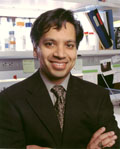Stem-cell-based therapies for heart diseases: ?We?re several years away from clinical trials, but the field is moving very fast?
25 Jul, 2006 04:27 pm
Deepak Srivastava reviews for Scitizen the potential of stem-cell-based therapies for heart disease.
The regeneration capacity is minimal which is the reason why individuals who have suffered a heart attack fail to regenerate their muscle and develop heart failure. However, there may be an ongoing low level of replacement of dying cells over a life time that just keeps the heart in a static state. Many people do believe that there’s a pool of progenitor cells in the adult heart that maintains the heart over a life time, but there is some controversy over the nature of those cells and what their capacity is.
What strategies are studied to isolate and modify the behaviour of these cells?
Like in the brain, it’s difficult to isolate those cells from the heart because of obvious technical issues. However, for experimental purposes there are various markers available to try to isolate these cells. That may be useful in trying to identify a way to make these cells within the heart, without removing them, expand for therapy purposes. We’re trying to develop such strategies to be able to both control the expansion of progenitor cells and trigger the differenciation of those cells into heart cells. But I think currently we don’t have these capabilities.
What other strategies can lead to efficient regenerative therapies for heart disease?
I think there’s a couple of approaches. One is to be able to trigger the cells that are already existing within the heart, the other is to introduce cells into a patient, either embryonic stem cell derived progenitors or cells derived from other sources of adult stem cells.
In a recent paper [1], you describe “many obstacles” that will need to be overcome? What are they?
They include achieving proper integration of the cells that may be introduced into the heart with the rest of the muscle. Another obstacle involves rejection. Much like a transplant has to be accepted by the host, embryonic stem cells that are introduced into a patient would have to be accepted and not rejected by the host. So mechanisms to address the immunological tolerance will have to be developed. And finally synchronizing any muscle introduced with the rest of the muscle tissues is critical in order to avoid rhythm disturbance during the cardiac cycles.
Which heart disease do you target with these regenerative therapies?
There’re several potential therapies. One is heart failure, where the heart has lost enough muscle that it’s incapable of supporting the body’s regulatory system. Another potential use is for the conduction system: loss of electrical conducting cells could be replaced with these progenitor cells. They can also be used to create new blood vessels in the heart.
Are we far from clinical trials?
We’re several years away from clinical trials, but the field is moving very fast, so it’s difficult to predict.
Deepak Srivastava, thank you.
Interview by Gilles Prigent
[1] Nature, 441, 1097-1099 (29 June 2006)
Deepak Srivastava is Director of the Gladstone Institute of Cardiovascular Disease at the University of California San Francisco, USA







 Read more
Read more